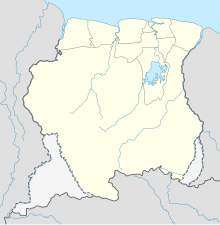Johan Adolf Pengel International Airport
|
Johan Adolf Pengel International Airport Paramaribo-Zanderij International Airport |
|||||||||||
|---|---|---|---|---|---|---|---|---|---|---|---|
 |
|||||||||||
| Summary | |||||||||||
| Airport type | Public | ||||||||||
| Operator | Johan Adolf Pengel International Airport (JAPIA) Corporation | ||||||||||
| Serves | Paramaribo | ||||||||||
| Location | Zanderij | ||||||||||
| Hub for | Surinam Airways | ||||||||||
| Elevation AMSL | 59 ft / 18 m | ||||||||||
| Coordinates | 05°27′10.19″N 55°11′16.02″W / 5.4528306°N 55.1877833°WCoordinates: 05°27′10.19″N 55°11′16.02″W / 5.4528306°N 55.1877833°W | ||||||||||
| Website | japi-airport.com | ||||||||||
| Map | |||||||||||
| Location in Suriname | |||||||||||
| Runways | |||||||||||
|
|||||||||||
|
Source: World Aero Data
|
|||||||||||
Johan Adolf Pengel International Airport (IATA: PBM, ICAO: SMJP), also known as Paramaribo-Zanderij International Airport, and locally referred to simply as JAP, is an airport located in the town of Zanderij and hub for airline carrier Surinam Airways, 45 kilometres (28 mi) south of Paramaribo. It is the larger of Suriname's two international airports, the other being Zorg en Hoop with scheduled flights to Guyana, and is operated by Airport Management, Ltd./ NV Luchthavenbeheer.
Prior to World War II, Zandery Airport was a Pan American World Airways (PAA) stop. In 1928 Pan American World Airways started mail flights from Miami to Paramaribo, the capital of the then Dutch colony Suriname. Pan American World Airways used Sikorsky S-38 amphibians. Rich and famous Americans, mostly aviators, visited Suriname. On 24 March 1934 female pilot Guggenheim and male pilot Russel Thaw had to make an emergency landing near the Nieuwe Haven, because they could not find Zanderij airfield. The Lockheed airplane was so severely damaged that it was shipped back to the USA. On 16 April 1934 female aviator Laura Ingalls landed in a single engine airplane, the Lockheed Air Express at Zanderij in the first solo flight around South America in a landplane. The KLM tri-motor Fokker F-XVIII, named the SNIP, made a trans-atlantic crossing from Amsterdam via Paramaribo to Curaçao, carrying mail. The trip of 12,200 km (more than 4,000 over water) landed 8 days after take-off from Schiphol, on 22 December 1934 at Hato Airport. Captain was J.J. Hongdong, co-pilot/navigator J.J. van Balkom, engineer L.D. Stolk, wireless operator S. v.d. Molen. The route was from Amsterdam via Marseille, Alicante, Casablanca, Cabo Verde, Paramaribo and Caracas. The SNIP landed at Zanderij Field on 20 December 1934 after a first trans-atlantic crossing of 3600 km, dubbed "the Christmas Mail-flight", directly from Porto Praia. However, the Snip flight did not inaugurate a regular KLM trans-Atlantic service. In January 1937 William Henry Vanderbilt III landed in a baby Clipper Sikorsky S-38 at Zanderij with wife and friends The Flying Hutchinsons. On 3 June 1937 aviation pioneer Amelia Earhart landed at Zanderij with a Lockheed Model 10 Electra at local time 2.38 P.M. The navigator was a retired PAA aviator Fred Noonan. This was on their second attempt of a "World Flight" en route from Miami to Natal and then transatlantic to Dakar, Senegal. They stayed overnight at the Palace Hotel in Paramaribo and left Zanderij again on Friday 4 June 1937 for Fortaleza, Brazil. One month later they disappeared over the central Pacific Ocean near Howland Island. On 16 March 1938 two pilots Whitney and Harmon made an emergency landing with their Beechcraft on an airstrip near the Eerste Rijweg. They could not find Zanderij Airfield. In 1938 the KLM started a weekly service between Paramaribo and Willemstad (Curaçao) with a twin engined Lockheed L-14 Super Electra able to carry 12 passengers and named MEEUW (PJ-AIM). Mail arrived much faster at Curaçao than with PAA, but the service was no commercial success. On 11 May 1939 The Flying Hutchinsons arrived at Zanderij in a twin engine Lockheed Electra, on their "family round-the-world global nations flight" which was broadcast on a radio series sponsored by Pepsi Cola.
...
Wikipedia

